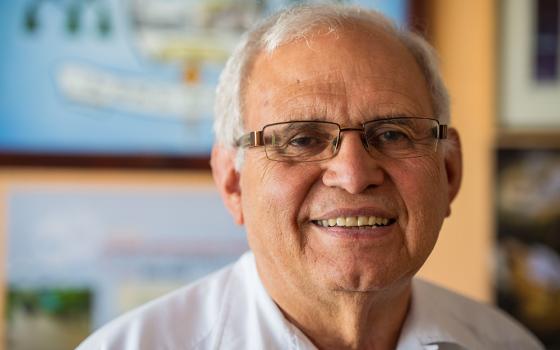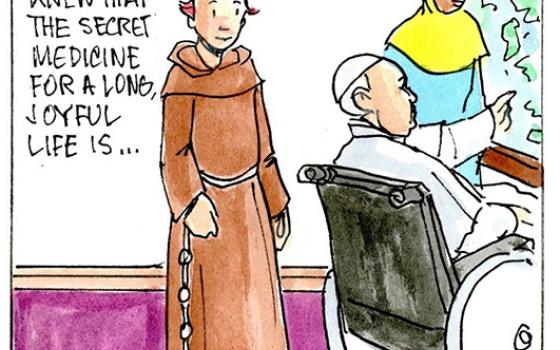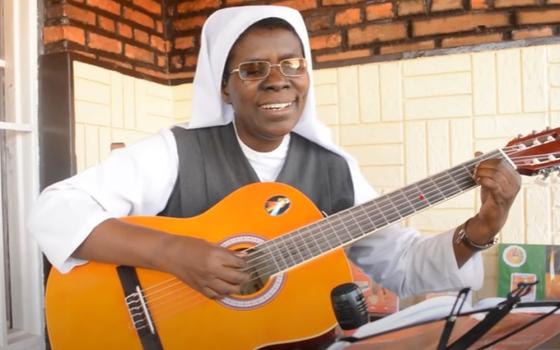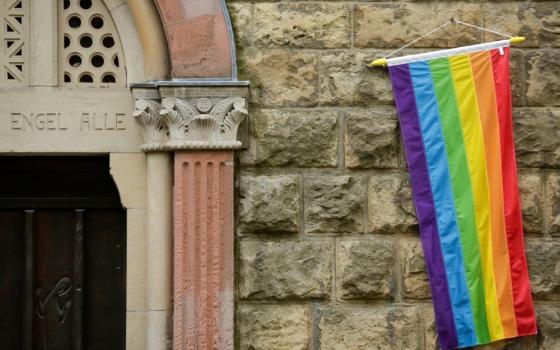Just back from two weeks in Ireland with my friends Fr. Bill and Fr. Patrick, where I went to get some perspective on life and the world, including recent events such as the U.S. killing of Gaddafi, the ending of the U.S. war in Iraq and the Occupy Wall Street movement.
Ever since I lived in Derry for a year, I've been returning to the old sod as often as possible to visit friends and catch that healing Celtic spirit. For some reason, that magical mystical landscape opens new insight into the inner landscape of my soul.
It was, of course, cold and rainy, but the green hills, white clouds, traditional music and witty, friendly people worked their magic.
In Ireland, when asked, for example, "How ya been keepin?", the answer is: "Poorly, thank God."
I was pleasantly surprised by the changes in Belfast. I didn't notice a thing -- and that's what was so remarkable. No British guns, tanks, soldiers or guard towers were apparent. In fact, it was hard to know when we crossed the border into Northern Ireland. Of course, there are deep tensions below the surface, but the terror and violence has stopped. The main concern everywhere is the economic collapse that has hit Ireland and all of Europe. Shops and restaurants are closing everywhere.
In Belfast, we spent an afternoon with my friend Mairead Maguire, the Nobel peace laureate, and friends at Peace People, her community-based peace group that promotes nonviolence at home and abroad.
Mairead was full of insight into the world's grief, and just on her way to South Africa to join Archbishop Tutu in Cape Town for a major conference on the Palestinian occupation. South African activists intend to compare their history of apartheid with Israel's unjust treatment of the Palestinians and call for new international pressure on Israel and the United States to end the occupation of the Palestinians.
In Galway, we walked Inishmore, the largest of the austere Aran Islands, to stand along the stark stone cliffs, look out across the ocean and explore the old stone ruins, especially of the abandoned monasteries and schools from 1,500 years ago.
In the fifth century, St. Edna brought Christianity to the Aran Islands, which became a leading center of monasticism and scholarship. Today, it's an island of limestone and green grass with a maze of criss-crossing stone walls. The cold, bracing wind breathed new life back into me, reminding me in the Celtic way of the essential things.
In County Tuam, we spent a few hours in Ballintubber Abbey, one of the oldest working cathedrals in the world. Founded in 1216 by Cathal O'Connor, it has had daily Mass for nearly 800 years. There amid the ruins, inside the ancient stone church, 30 lively teenagers were discussing the life of Jesus for their confirmation retreat. The marvelous elderly pastor showed us around, pointed out the oldest carvings, told us a few legends of Celtic spirituality and kept us laughing.
Near Croagh Patrick, we visited the grave and museum to Michael Davitt, the 19th century hero of nonviolence who led the Land League movement and invented the boycott as a method of resistance against British injustice. Along with Daniel O'Connell, he is one of Ireland's greatest peacemakers. He inspired countless Irish tenant-farmers to resist British occupation through nonviolent, public demonstrations that helped the rural poor reclaim their land. These efforts paved the way for Irish democracy and eventual independence. Gandhi was greatly inspired by Davitt's efforts and wrote several essays about him.
In later years, Davitt traveled the world speaking for justice on behalf of struggling people everywhere. He became one of the first truly global activists to address every issue and encourage every nonviolent movement. He spoke in South Africa, Russia, South America, Palestine, Australia, New Zealand and made 10 trips to the United States, where his relatives lived and his parents are buried. He died in Dublin in 1906 at the age of 60 after a lifetime of tireless advocacy. What an inspiration for all of us! His spirit lives on in many Irish peacemakers, most notably Mairead Maguire.
In Kilkenny, in the southeast, we spent a day with Jane O'Malley, widow of the legendary painter Tony O'Malley, who died a few years ago. Many consider Tony O'Malley to be the best Irish painter of the last hundred years, maybe one of the world's best modern painters. Jane toured us through their home, studio and vault and shared her reflections on art and Irish life, as well as her own magnificent paintings. It was a magical day with a true Irish artist.
But it was our visit to Clonmacnoise Abbey, in the center of the country, that touched me most deeply. I'd never been there before, even though it's off the main road, not far from Athlone. These stone ruins from the ancient abbey, monastery and schools built almost 1,500 years ago have become a classic Irish image. The cathedral, two stone churches, the famous Celtic "Cross of the Scriptures," the two tall round towers, the stone walls and graves and ancient inscriptions have come to represent Ireland to the world.
Clonmacnoise Abbey was founded by the remarkable young St. Ciaran sometime between 545 and 548 along the Shannon River on the main east-west land route. He died a year later at age 33 but inspired kings, monks and the faithful across the land to join his monastery, which quickly became a center for Christianity, education, trade and craftsmanship for the next 500 to 700 years.
Like the Jesuit Reductions of Latin America (as portrayed in the film "The Mission"), Clonmacnoise was a center for peace. The population grew from the original 10 men to perhaps 1,500 to 2,000 by the 11th century. But it was disturbing to learn in the beautiful visitor's center how the monastery was attacked more than 50 times over several centuries by the Irish, the Vikings and the Anglo-Normans until it was completely obliterated. Hundreds of monks were killed over the years and the churches and schools were repeatedly pillaged and burned until finally the British took everything they could find, leaving only a pile of stones.
Sitting alone in the ruins of one of the stone churches, I felt the tide of history wash over me as I pondered those early Christians, trying to live in the peace of Christ 1,500 years ago by the Shannon River. How many countless, anonymous Christians across the centuries have tried similarly to live according the Gospel mandate through prayer, worship, service, loving, kindness, community and peace, only to be knocked down by the forces of greed, war and empire. Their struggle is our own struggle. Not much has changed.
There in those ruins, I remembered an astonishing unpublished speech by Daniel Berrigan from 1965, which I discovered while studying his archives at Cornell University and added to my recent collection, Daniel Berrigan: Essential Writings.
Speaking about the impending Vietnam War, Dan told students that people of peace and nonviolence are people of history. They carry a conscious, long-haul, historical view of themselves in the context of world history. They know well the old story of war and violence and have chosen to place themselves instead in the alternative history of peace and nonviolence. They choose to join the small movements and streams of peace and nonviolence that flow through the centuries in the hope that they might grow over time and lead to a new history of peace. In doing so, they choose not to spend their short time on earth aiding and abetting the history of war. They seek to create a new history of peace. That's the journey from St. Ciaran to Michael Davitt to Mairead Maguire. That's the journey we're invited to join.
That's what the anonymous saints, monks and faithful of Clonmacnoise Abbey tried to do. There in those old stone ruins, I remembered my own place in Christian history, as one of the countless, anonymous Christians who renounces the cycle of war, greed and violence and chooses instead Christ's alternative way of peace and nonviolence.
Sitting in the ruins of the old church, I noticed that the drizzle had stopped and looked up at the open sky to see the clouds part, the blue sky appear and the sun shine. With that consolation, my Irish pilgrimage was complete.
"How can people be so insensitive to the dignity and independence of landscape?" our friend the late Irish writer John O'Donohue asks in his posthumously published new book, The Four Elements. "Expressed spiritually, each place has its own texture and spirit." He writes about how earth and stone, wind and air continue "to transfigure and praise the silence of time." I'll end with one of John's blessings, that his Irish prayer and praise may uplift us all:
Let us bless
The imagination of the Earth.
That knew early the patience
To harness the mind of time…
Let us thank the Earth
That offers ground for home
And holds our feet firm
To walk in space open
To infinite galaxies.
Let us salute the silence
And certainly of mountains:
Their sublime stillness,
Their dream-filled hearts…
The humility of the Earth
That transfigures all
That has fallen
Of outlived growth.
The kindness of the Earth,
Opening to receive
Our worn forms
Into the final stillness.
Let us ask forgiveness of the Earth
For all our sins against her:
For our violence and poisonings
Of her beauty.
Let us remember within us
The ancient clay,
Holding the memory of seasons,
The passion of the wind,
The fluency of water,
The warmth of fire,
The quiver-touch of the sun
And shadowed sureness of the moon.
That we may awaken
To live to the full
The dream of the Earth
Who chose us to emerge
And incarnate its hidden night
In mind, spirit and light.
***
This week, John Dear will speak at the National Heritage Museum in Lexington, Mass. and receive the Sr. Marguerite d'Youville Humanitarian Award. Later, he will help present Joan Baez with the "Courage of Conscience" Award from the Peace Abbey. John Dear's new book, Lazarus, Come Forth!, is available from Amazon.com. Next year, John will undertake a national book tour to discuss this Gospel confrontation of the God of life and peace against the culture of death and war. To host John for an evening talk, send an email through his website. His other recent books, including Daniel Berrigan: Essential Writings; Put Down Your Sword and A Persistent Peace, are also available from Amazon.com. To contribute to Catholic Relief Services' "Fr. John Dear Haiti Fund," go to: donate.crs.org/goto/fatherjohn. For more information, go to John Dear's website.




